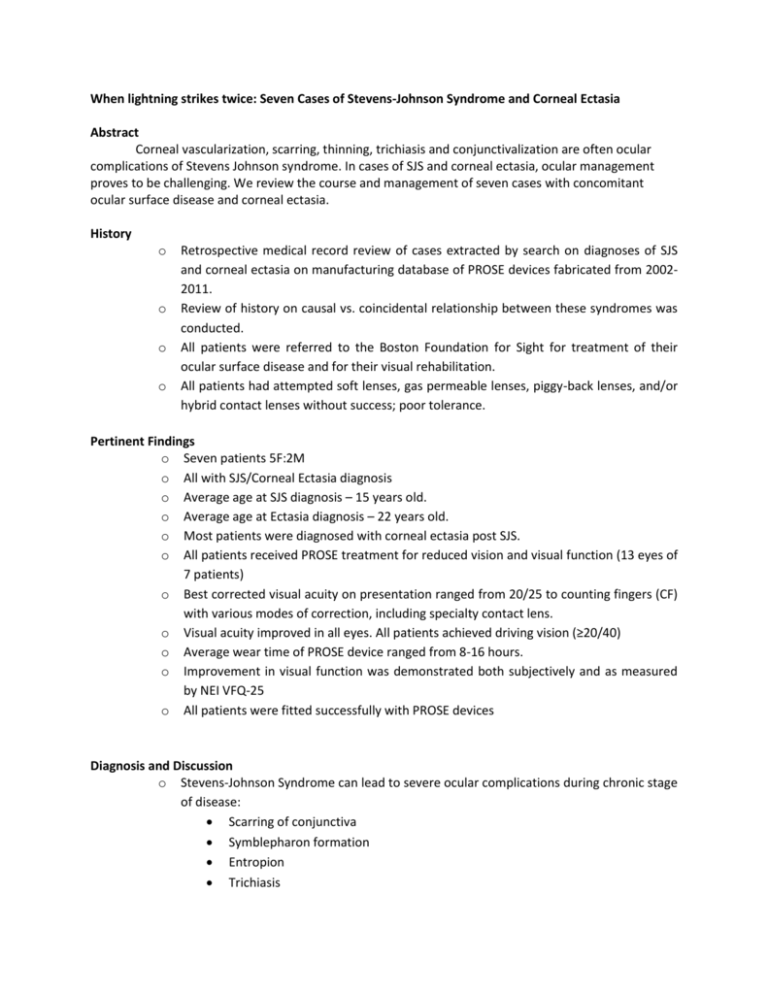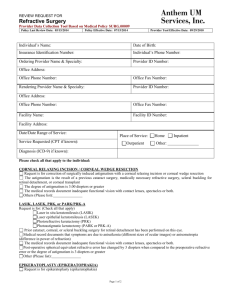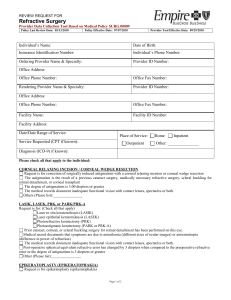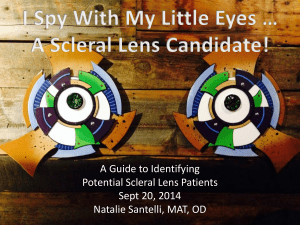outline31485
advertisement

When lightning strikes twice: Seven Cases of Stevens-Johnson Syndrome and Corneal Ectasia Abstract Corneal vascularization, scarring, thinning, trichiasis and conjunctivalization are often ocular complications of Stevens Johnson syndrome. In cases of SJS and corneal ectasia, ocular management proves to be challenging. We review the course and management of seven cases with concomitant ocular surface disease and corneal ectasia. History o o o o Retrospective medical record review of cases extracted by search on diagnoses of SJS and corneal ectasia on manufacturing database of PROSE devices fabricated from 20022011. Review of history on causal vs. coincidental relationship between these syndromes was conducted. All patients were referred to the Boston Foundation for Sight for treatment of their ocular surface disease and for their visual rehabilitation. All patients had attempted soft lenses, gas permeable lenses, piggy-back lenses, and/or hybrid contact lenses without success; poor tolerance. Pertinent Findings o Seven patients 5F:2M o All with SJS/Corneal Ectasia diagnosis o Average age at SJS diagnosis – 15 years old. o Average age at Ectasia diagnosis – 22 years old. o Most patients were diagnosed with corneal ectasia post SJS. o All patients received PROSE treatment for reduced vision and visual function (13 eyes of 7 patients) o Best corrected visual acuity on presentation ranged from 20/25 to counting fingers (CF) with various modes of correction, including specialty contact lens. o Visual acuity improved in all eyes. All patients achieved driving vision (≥20/40) o Average wear time of PROSE device ranged from 8-16 hours. o Improvement in visual function was demonstrated both subjectively and as measured by NEI VFQ-25 o All patients were fitted successfully with PROSE devices Diagnosis and Discussion o Stevens-Johnson Syndrome can lead to severe ocular complications during chronic stage of disease: Scarring of conjunctiva Symblepharon formation Entropion Trichiasis o o o o Tear film disturbances Corneal involvement i. Scarring ii. Neovascularization iii. Keratinization iv. Thinning v. Conjunctivilization Lacrimal Duct involvement i. Cicatrization ii. Destruction of Goblet Cells Limbal stem cell deficiency SJS eyes often develop: Corneal Opacities Corneal erosions Epithelial breakdowns Ulceration Infectious Keratitis Because of limbal stem cell deficiency, SJS eyes are poor candidates for corneal transplants. Corneal ectasia: Decreased best corrected visual acuity Often times spectacle correction or soft lens correction are not viable options Require specialty contact lenses; rigid gas permeable (GP) lens correction For highly ectatic and irregular corneas, corneal GP lenses may be unstable Often if complications with GP lenses, alternative approach is corneal transplants. Concomitant SJS and corneal ectasia is particularly challenging: Traditional GP lenses for ectasia visual rehabilitation are poorly tolerated in SJS patients Option of penetrating keratoplasty is not viable one in concomitant cases of SJS Treatment and Management o Prosthetic replacement of the ocular surface system (PROSE) treatment Use of scleral prosthetic devices. o These are FDA-approved custom designed and fabricated prosthetic devices: Restore vision, Support healing Reduce symptoms Improve quality of life for patients suffering with complex corneal disease Large diameter (average 15.5–23 mm) Designed to rest entirely on the sclera Vault entirely the cornea Creating a space filled with preservative-free artificial tears or saline They are fluid-ventilated Allow the containment of an oxygenated pool of artificial tears free of air bubbles over the cornea o This case: All patients were custom-fitted with a scleral prosthetic device Devices were worn on a daily wear schedule Improved best corrected visual acuity and visual function in all eyes. Significant decrease in dry eye symptoms, pain, and photophobia. In five out of seven patients, ectasia developed after SJS onset. PROSE treatment: Adequate ocular surface support in refractory disease Viable and excellent choice for both SJS and corneal ectasia i. Excellent treatment option for concomitant cases of both complex ocular surface disease and ectasia Passive and non-invasive treatment ii. No surgical intervention iii. Potentially precludes need for further surgical intervention need o Patients with corneal ectasia and concomitant ocular surface disease from StevensJohnson syndrome pose a special challenge for visual rehabilitation. Contact lens may be poorly tolerated, difficult to fit, and penetrating keratoplasty is high risk. PROSE treatment is a useful option for patients such as these with complex corneal disease. There is not enough data in the literature to confirm a causal vs. coincidental relationship between SJS and corneal ectasia. The fact that 5 out of the 7 patients in our series were diagnosed with ectasia some time after SJS diagnosis may suggest that severe ocular surface microtrauma maybe a factor in developing ectasia. More data is needed to further conclude on a causal vs. coincidental relationship between SJS and corneal ectasia. Conclusion o o o o o References 1. Rosenthal P, Croteau A. Fluid-ventilated, gas permeable Scleral contact lens is an effective option for managing severe ocular surface disease and many corneal disorders that would otherwise require penetrating keratoplasty. Eye & Contact Lens. 2005; 31(3) 130-134. 2. Mangione C, Lee P, Gutierrez P, Spritzer K, Berry S, Hays R. Development of the 25-item National Eye Institute Visual Function Questionnaire (VFQ-25). Arch Ophthalmol 2001; 119:1050 –1058. 3. Romero-Rangel T, Stavrou P, Cotter J, Rosenthal P, Baltatzis S, Foster CS. Gas-permeable scleral contact lens therapy in ocular surface disease. Am J Ophthalmol. Jul 2000;130(1):25-32. 4. Stason WB, Razavi M, Jacobs DS, Shepard DS, Suaya JA, Johns L, Rosenthal P. Clinical Benefits of the Boston Ocular Surface Prosthesis. Am J Ophthalmol. 2010; 54-61. 5. Sunita Agarwal, Athiya Agarwal, David J Apple (2002) Textbook of Ophthalmology; Jaypee Brothers Publishers, pg. 872.







